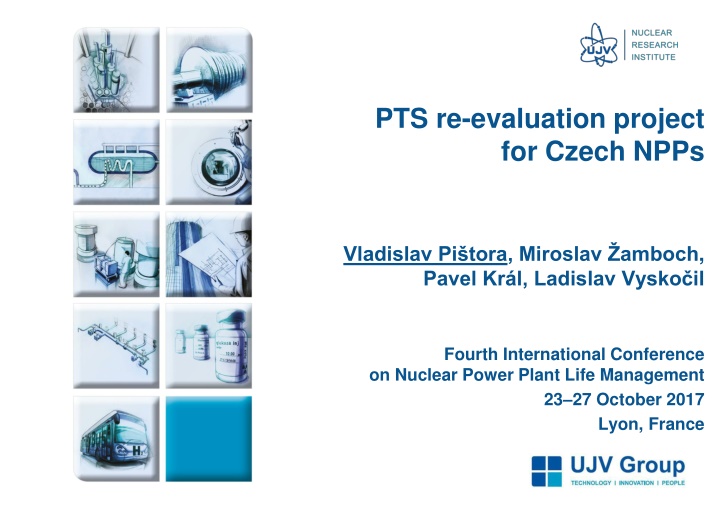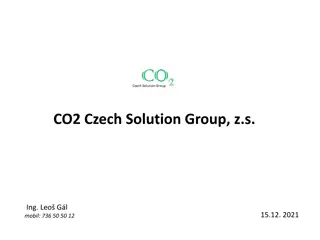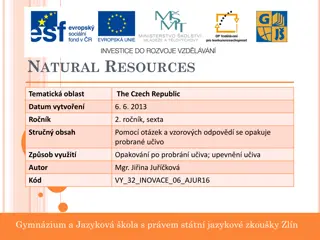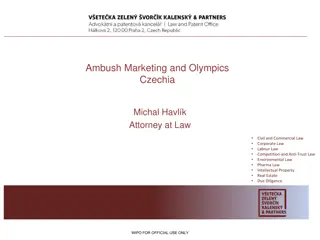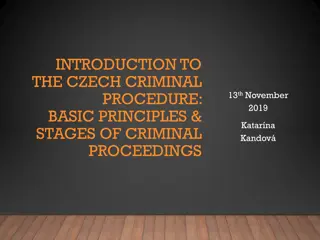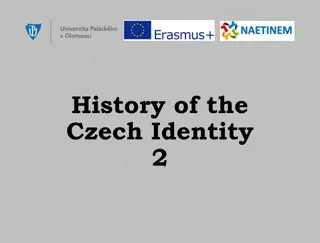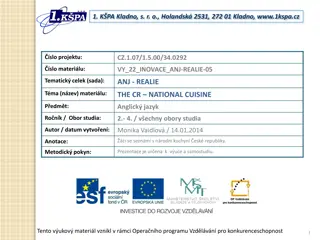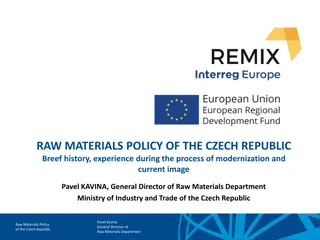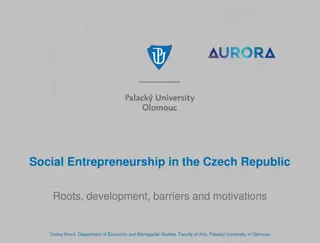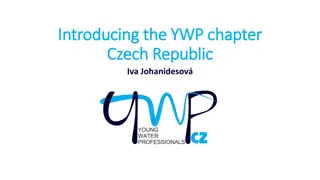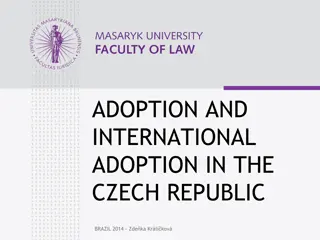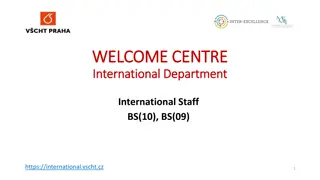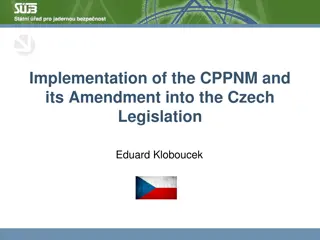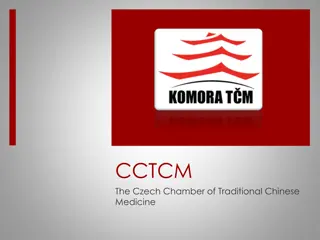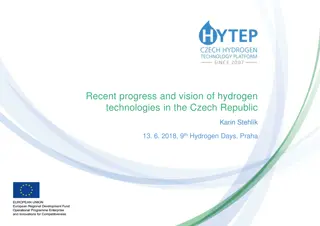Re-evaluation Project for Czech NPPs in Fourth International Conference
Reactor Pressure Vessel (RPV) plays a crucial role in nuclear power plants (NPPs) and requires periodic reassessment for material degradation limits due to radiation embrittlement, such as pressurized thermal shock (PTS). This article discusses the PTS analyses and normative documents used in assessing the RPV lifetime for Czech NPPs, highlighting the multidisciplinary nature of PTS evaluations and the key components involved in the process.
Uploaded on Oct 08, 2024 | 0 Views
Download Presentation

Please find below an Image/Link to download the presentation.
The content on the website is provided AS IS for your information and personal use only. It may not be sold, licensed, or shared on other websites without obtaining consent from the author.If you encounter any issues during the download, it is possible that the publisher has removed the file from their server.
You are allowed to download the files provided on this website for personal or commercial use, subject to the condition that they are used lawfully. All files are the property of their respective owners.
The content on the website is provided AS IS for your information and personal use only. It may not be sold, licensed, or shared on other websites without obtaining consent from the author.
E N D
Presentation Transcript
PTS re-evaluation project for Czech NPPs Vladislav Pi tora, Miroslav amboch, Pavel Kr l, Ladislav Vysko il Fourth International Conference on Nuclear Power Plant Life Management 23 27 October 2017 Lyon, France
Introduction Reactor pressure vessel (RPV) is a key component of nuclear power plant (NPP) that can limit the NPP lifetime. Radiation embrittlement due to neutron fluence is the most significant aging mechanism for RPV. For the RPV lifetime assessment, material degradation limit has to be established. This limit is established on the basis of pressurised thermal shock (PTS) analyses: PTS is an event in NPP that is characterized by rapid cooldown in the primary coolant system with (usually) high primary pressure. PTS analyses are a multidisciplinary task. They consist of a series of thermal hydraulic and structural analyses. Two NPPs are operated in the Czech Republic by the EZ company: Dukovany NPP (4 units of WWER 440/213 type, start of operation 1985), Temel n NPP (2 units of WWER 1000/320 type, start of operation 2000). The original assessment of PTS was performed for NPP Dukovany during 1996 2004, for NPP Temel n during 2001 2004. 1
General scheme of PTS analyses according to VERLIFE Postulated cracks in RPV RPV embrittlement Input data for structural analysis Neutron fluence prediction Selection of PTS scenarios NDE qualification, standards Material degradation prediction (standards, surveillance programme) TH system analyses TH mixing analyses FE model of RPV Temperature and stress fields Fracture mechanics stress intensity factor KI Prediction of critical temperature of brittleness Tk or Master curve reference tamperature T0 Maximum allowable critical temperature of brittleness Tka or maximum allowable Master curve reference temperature T0a Tk < Tka or T0 < T0a 2
Normative documents used for the PTS evaluation Guidelines on Pressurized Thermal Shock Analysis for WWER Nuclear Power Plants, Revision 1, IAEA-EBP-WWER-08 (Rev. 1), IAEA, Vienna, 2006 Unified Procedure for Lifetime Assessment of Components and Piping in VVER NPPs, VERLIFE, ver. 2003 (the basis for the first PTS Temel n project) Normative Technical Documentation of Association of Mechanical Engineers (NTD ASI), Section IV, ver. 2004 (Czech equivalent of VERLIFE, ver. 2003) Unified Procedure for Lifetime Assessment of Components and Piping in VVER NPPs, VERLIFE, ver. 2008 Normative Technical Documentation of Association of Mechanical Engineers (NTD ASI), Section IV, ver. 2013 (Czech equivalent of VERLIFE, ver. 2008) IAEA NULIFE Guidelines for Integrity and Lifetime Assessment of Components and Piping in WWER NPPs During Operation (VERLIFE), to be published Normative Technical Documentation of Association of Mechanical Engineers (NTD ASI), Section IV, ver. 2017 (based on IAEA NULIFE VERLIFE) Note: UJV Rez was a co-author of the IAEA, the NTD ASI and the VERLIFE guidelines. 3
Overview of PTS events analysed for NPP Dukovany within the original PTS assessment Overview of TH analyses performed in PTS evaluation: 1) Main steam line break (MSLB) or other large secondary leaks system thermal-hydraulic (TH) analyses of 12 variants of this event mixing analyses of the 3 worst cases o o IE group System TH analyses Mixing calculations Structural analyses 2) Primary-to-secondary leak (PRISE) o system TH analyses of 17 variants o mixing analyses of 10 worst variants MSLB PRISE LOCA OTHER Total 12 17 22 18 69 3 8 10 14 3 30 10 13 7 38 3) Loss-of-coolant accident (LOCA) o system TH analyses of 22 variants o mixing analyses of 14 worst variants 4) Other events - inadvertent opening of pressurizer safety valve (PRZ SV), false initiation of safety injection (SI) or make-up, feed&bleed, flooding of reactor cavity etc. o system TH analyses of 18 cases o mixing analyses of 33 worst cases The original PTS assessments were performed for surface-breaking postulated cracks, finally 6 worst scenarios were recalculated for underclad cracks. As the most severe PTS was identified the regime LOCA DN 200 mm break in hot leg . 4
Overview of PTS events analysed for NPP Temeln within the original PTS assessment Overview of TH analyses performed in PTS evaluation: IE group System TH analyses Mixing calculations Structural analyses MSLB PRISE LOCA OTHER Total 13 15 18 26 72 4 2 5 4 2 5 13 24 13 24 As the most severe PTS was identified the regime Inadvertent opening of PRZ SV with subsequent reclosure . 5
PTS re-evaluation project Within preparation of Dukovany NPP for long term operation, PTS re- evaluation project was started. It is obvious that since that time some changes in the NPP equipment, procedures etc. have been performed and also the applied methodology for PTS assessment has been improved. Moreover, significant improvement of software tools and hardware capabilities proceeded, which enabled improvement of applied models. This was one of the reasons for starting the PTS re-evaluation project. Due to these facts, PTS re-evaluation project was started also for Temel n NPP. The PTS re-evaluation project is beeing performed during 2016 - 2018. During the current PTS re-evaluation project, the most significant PTS scenarios are being recalculated. 6
Main new features of PTS analyses in the current PTS re-evaluation project System thermalhydraulic (TH) analyses updated RELAP5 models considering current status of both Dukovany and Temel n NPP. Mixing TH analyses using CFD code Ansys-FLUENT instead of regional mixing code REMIX/NEWMIX used in the original PTS assessment significant improvement of modelling. Structural analyses application of IAEA-NULIFE VERLIFE new postulated crack, new warm pre-stressing (WPS) approach (possible application for non-monotonic loading), new formulae for residual stresses in weld, heat affected zone and RPV cladding. 7
System thermal hydraulic (TH) analysis model for Temel n NPP and example of results Nodalization of VVER-1000 for RELAP5: Input model statistics: 1800 control volumes 2400 hydraulic junctions 1600 heat structures with 8700 mesh points 2680 control variables 1110 trips Primary circuit (1/4) Containment 0 2 0 0 2 1 0 1 9 Main steam system S V1 S V2 P S V 4 8 4 4 8 5 4 8 3 Active ECCS (1/3) P G4 4 9 2 1 2 3 4 5 6 7 RCA+ zp et. k la p k a 4 8 2 8 9 1 0 1 1 1 4 8 6 4 8 7 2 RZ V 3 4 8 8 0 1 7 0 1 8 0 1 6 9 2 9 4 5 4 9 0 4 9 1 4 8 9 T G4 S V1 S V2 3 8 5 P S V 3 8 4 3 8 3 P G3 3 9 2 1 2 3 4 5 6 7 8 9 RCA+ zp et. k la p k a 3 8 2 1 0 9 1 6 9 1 8 1 1 1 2 1 3 1 3 8 6 3 8 7 2 3 2 3 2 1 4 1 4 RZ V 917 3 919 3 8 8 0 1 4 0 1 5 0 1 3 9 2 8 4 5 3 9 0 3 9 1 0 2 6 3 8 9 S V1 S V2 2 8 5 P S V T G3 0 2 7 2 8 4 2 8 3 0 2 5 9 0 2 9 1 4 1 2 3 4 5 6 7 8 915 9 FW system P G2 1 0 1 1 1 2 1 3 2 9 2 1 2 3 4 5 6 7 8 9 1 0 RCA+ zp et. k la p k a 1 4 P S K1 2 8 2 8 2 1 1 2 6 2 7 1 5 1 2 1 3 1 4 2 5 1 1 6 1 7 1 8 1 9 2 0 2 1 2 2 2 3 2 4 2 8 7 2 8 6 2 RZ V 3 2 8 8 4 HP K 9 2 7 5 2 9 0 2 9 1 9 0 1 2 8 9 T G2 0 1 0 903 P S V 1 8 3 0 1 1 0 1 2 9 0 4 S V1 S V2 1 8 5 0 2 2 1 8 4 9 0 0 5 6 7 1 7 9 9 0 8 1 2 3 4 5 6 7 8 9 1 0 1 1 909 1 2 8 1 3 1 4 4 1 5 1 7 8 4 1 7 7 4 9 P S K2 2 3 1 6 3 0 2 8 2 9 5 1 7 5 3 3 2 7 1 8 2 6 1 9 2 0 2 1 2 2 2 3 2 4 2 5 2 6 2 6 1 1 1 9 8 9 0 2 3 0 2 4 P G1 1 9 2 9 9 0 RCA+ zp et. k la p k a 1 2 3 4 5 6 7 8 911 913 1 8 2 9 9 1 2 9 1 0 1 0 1 1 1 2 1 5 5 1 8 7 1 8 6 3 4 3 4 2 2 2 RZ V 1 1 3 1 8 8 4 9 2 6 5 1 9 0 1 9 1 1 8 9 T G1 8
System TH analysis model for Temeln NPP and example of results Example of results of system TH analysis scenario PSV73: Inadvertent opening of PRZ SV with 3 operating high-pressure safety injection pumps 18.0E+6 Primary pressure drop due to false opening of PRZ safety valve 16.0E+6 14.0E+6 Effect of operator switch-off of safety injection pumps 12.0E+6 pressure [Pa] 10.0E+6 8.0E+6 6.0E+6 Opening of secondary steam dump 4.0E+6 2.0E+6 000.0E+0 -1000 0 1000 2000 3000 4000 5000 time [s] primary pressure (PRZ) steam pressure (SG1) MSH pressure Variation of primary and secondary pressure 9
System TH analysis model for Temeln NPP and example of results 160 500000 450000 140 400000 Inadvertent opening of PRZ safety valve 120 350000 Transfer from steam to two-phase flow 100 300000 flow [kg/s] mass [kg] 250000 80 200000 60 150000 40 100000 20 50000 0 -1000 0 0 1000 2000 3000 4000 5000 time [s] PRZ RV PRZ SV1 PRZ SV2 integral of total flow Flow at pressurizer safety valve and its integral 10
System TH analysis model for Temeln NPP and example of results 250 450000 Restart and final stop of 1 HP pump Operator reduction of injecting HP pumps Start of injection of 3 high pressure (HP) pumps 400000 200 350000 300000 150 flowk [kg/s] 250000 mass [kg] 200000 100 150000 Intermittent injection of accumulators 100000 50 50000 0 -1000 0 0 1000 2000 time [s] 3000 4000 5000 PTTQ (TQx4) HPSI (TQx3) HDA LPSI (TQx2) integral of total flow Injection of safety systems 11
Mixing calculation model for Temeln NPP and example of results Coolant mixing is simulated by the CFD code Ansys FLUENT (for single-phase scenarios only). Computational domain covers cold legs with ECCS injections, downcomer and lower plenum including solid walls. An example of CFD model for mixing simulation in VVER-1000 reactor is shown below. Only a fluid domain is displayed. The model also contains solid walls. The computational mesh contains about 2 millions of cells. Arrows denote inlets into the computational domain 12
Mixing calculation model for Temeln NPP and example of results Initial and boundary conditions for the mixing simulation in FLUENT are used based on the system TH analysis performed with RELAP5 code. Boundary conditions for the CFD simulation are time variations of: mass flow rate and temperature of ECCS injections, mass flow rate and temperature of coolant at cold leg inlets and reactor inlets. The goal of the simulation is to calculate time evolution of temperature field at wetted surfaces of the reactor pressure vessel wall and cold legs. The results serve as an input for the subsequent structural analysis. CFD simulations of mixing for PTS evaluation are computationally expensive. 13
Mixing calculation model for Temeln NPP and example of results Example of calculated case: Scenario Inadvertent opening of PSV with three operating high-pressure injection pumps at NPP Temel n (PSV73). Thermal stratification in cold leg with ECCS injection. Cold plumes in downcomer Calculated temperatures [ C] of wetted surfaces, PSV73 scenario, time 550 s. 14
Mixing calculation model for Temeln NPP and example of results Comparison of results from FLUENT and RELAP5 codes Time variation of wall surface temperatures at RPV weld 4, PSV73 scenario. 15
Mixing calculation model for Dukovany NPP Another example of CFD model for mixing: VVER-440 reactor. Only a fluid domain is displayed. The model also contains solid walls. The computational mesh contains about 2 millions of cells. Arrows denote inlets into the computational domain 16
Structural analysis model Finite element model of cylindrical part of RPV created. Crack postulated in accordance with VERLIFE: semielliptical underclad crack partially (1 mm) penetrating into cladding, crack postulated in welds No. 3 and 4 (Temel n NPP) or in weld No. 4 (Dukovany NPP) in beltline zone, axial and circumferential orientations of crack, aspect ratios a/c = 0,3 and 0,7, crack depth a = 13 + 1 mm (based on NDE qualification requirements and results). In total, 8 (4) models for 8 (4) postulated crack configurations created for Temel n (Dukovany) NPP. SYSTUS FEM code used for the analyses. Heat transfer transient analysis performed as the 1ststep. Elastic-plastic analysis performed as the 2ndstep for loading by residual stresses, dead weight, inner pressure and transient temperature field. 17
Structural analysis model for Temeln NPP FEM mesh the whole model and detail of the crack (in section) 18
Structural analysis fracture mechanics assessment In the post-processor of the SYSTUS code, the energy release rate G is calculated using G-theta method for all nodes of the crack front and for all time steps. From value of G, value of stress intensity factor KIis calculated using the following formula: 2 1 E G = K I Allowable value of stress intensity factor [KIC]3 : critical temperature of brittleness approach exp min + = 36 26 3 IC K ( ) 1 2 0 02 200 . ; MPa m T T k Master curve approach min = 3 KIC ( ) + 1 2 25 2 36 6 0 019 200 . . exp . ; MPa m T T 0 Size correction is performed within Master curve approach. The warm pre-stressing approach or the tangent approach is used for determination of maximum allowable reference temperature Tka or T0a. 19
Structural analysis example of results for Temeln NPP PSV73 circumferential stress at time 3750 s (model for weld 3, axial crack, a/c=0,7) 20
Structural analysis example of results for Temeln NPP 21PSV73 KIvs. T and [KIC]3vs. T diagrams (weld 3, axial crack, a/c = 0,7)
Overview of PTS scenarios for Dukovany NPP analysed within the current PTS re-evaluation project until now Abbreviation Name Inadvertent opening of PRZ SV with reclosure in 1800 s, maximum ECCS, full power PSV23n-r1800 LOCA break in hot leg with equivalent diameter Dn 200 mm, maximum ECCS, full power LOCA_H200_2016 3 steam generator tubes rupture, maximum ECCS, zero power, non-closure of main isolation valve PRISE SGTR3a 3 steam generator tubes rupture, maximum ECCS, zero power, closure of main isolation valve PRISE SGTR4a PRISE SGIMF6 SG cold collector head loosening, minimum ECCS, 22
Overview of planned analyses for Dukovany NPP within the current PTS re-evaluation project for 2017 - 2018 Abbreviation Name Break of main steam line in hermetic zone, stuck-open PRZ SV (single failure) Break of main steam line in hermetic zone, stuck-open PRZ SV and its later reclosure by operator LOCA H30z.maxLOCA break in hot leg with equivalent diameter Dn 30 mm, maximum ECCS, zero power LOCA H90n.maxLOCA break in hot leg with equivalent diameter Dn90 mm, maximum ECCS, full power LOCA D500 H&C ECCS condition - question of further discussion, full power SLIz3o SLIz3r LOCA rupture of hot leg with equivalent diameter Dn 2x500 mm, FW Flooding reactor cavity by rupture of feedwater pipe 23
Overview of PTS scenarios for Temeln NPP analysed within the current PTS re-evaluation project until now Abbreviation Name Inadvertent opening of PRZ SV with reclosure at 1500 s, maximum ECCS, full power PSV73zr Inadvertent opening of PRZ SV, maximum ECCS, full power PSV73 Inadvertent opening of PRZ SV with reclosure at 1500 s, minimum ECCS, full power PSV71zra Inadvertent opening of PRZ SV with reclosure at 1500 s, minimum ECCS, zero power PSV83zr LOCA Dn 32 mm, minimum ECCS, zero power LOCA 32min 24
Overview of planned analyses for Temeln NPP within the current PTS re-evaluation project for 2017 - 2018 Abbreviation Name 3 steam generator tubes rupture (cold collector), minimum ECCS, zero power feed and bleed LOCA - break of pipe between PRZ and PRZ SV Dn 210 mm, minimum ECCS, full power Steam generator head lift (equivalent diameter Dn 40 mm) maximum ECCS, zero power LOCA - break of hot leg with equivalent diameter Dn 300 mm, minimum ECCS, full power LOCA - break of hot leg with equivalent diameter Dn 2x850 mm, maximum ECCS, full power Main steam line break near SG 1, minimum ECCS (injection to loop 3), zero power MSLB SLB1C Main steam line break near SG 1, maximum ECCS, zero power Main steam line break near SG 1, minimum ECCS (injection to loop 1), zero power PRISE 3SGT FB1 LOCA PP210min PRISE SGH1 H300min H850 MSLB SLB1B MSLB SLB1A 25
Conclusions Within the Dukovany (1996 - 2004) and Temel n (2001 - 2004) original PTS projects, a large number of PTS scenarios were analysed. Within the current PTS re-evaluation project (2016 2018) all significant PTS scenarios are being recalculated based on current NPP status, current methodology and state of the art models. 5 PTS scenarios for NPP Dukovany and 5 PTS scenarios for NPP Temel n have been analysed until now. 26
Conclusions, cont. More Ansys-FLUENT are performed which leads to more realistic results. In most cases, current results for re-evaluated PTS regimes show less adverse results than results obtained within the original PTS projects, which suggests good perspective for LTO. At least 6 new full PTS analyses for NPP Dukovany and 9 new full PTS analyses for NPP Temel n are planned for 2017 2018. After finalising the planned PTS analyses, the worst cases will be re-assessed with the aim procedures. PTS analyses for the RPV inlet nozzle region will be performed for selected scenarios at the end of the project. precise TH mixing analyses using CFD code to optimize the emergency 27
